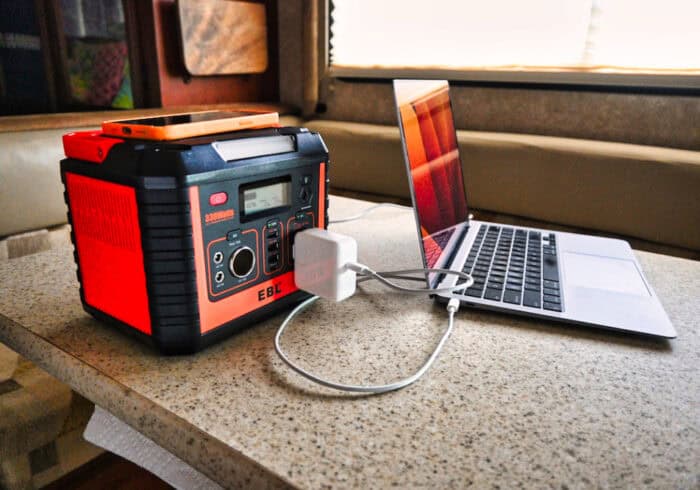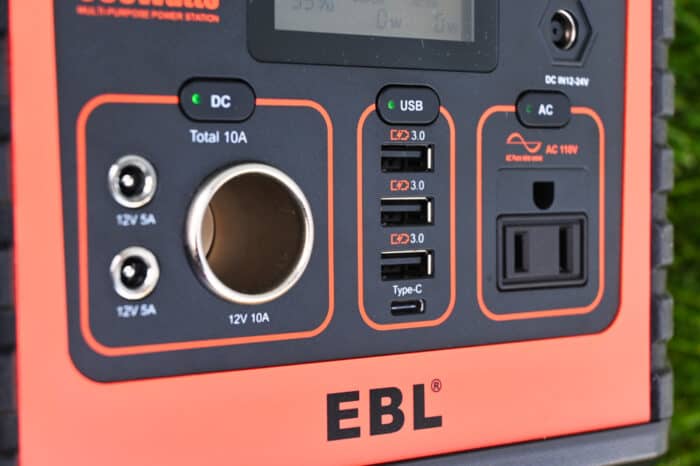Disclaimer: EBL sent this product to us for free for a review. That does not affect our opinion about the product. In this article, we list both what we like and dislike. Read more about this here.
The EBL 300/MP330 Is A Small Power Station For Travelers
In today’s article, I will be reviewing the EBL 300 which is a portable power station with all of the charging ports you might need on a weekend trip.

It’s not a power station that can power kitchen appliances, but it will keep your smaller electronics charged. It’s powerful enough to power things like a TV, lights, a 12V fridge, and similar devices.
Let’s dive into the specifications of the EBL 300, before I share what I like and don’t like about this specific product.
EBL 300 – Specifications
Battery Capacity
The lithium-ion batteries inside of the EBL 300 stores up to 288.6Wh.
If we do a quick calculation and assume an 85% inverter efficiency rate, it can power a 50W device for almost five hours.
Power Inverter
The pure sine wave inverter can output up to 330W continuously, with a peak of 600W.
I could pull 280W with no problems. A fan turned on to cool the inverter down, and that does get pretty loud so you might not want to sleep right next to it.

Ports
There is a single AC outlet, three USB A, one USB C, one 12V cigarette lighter port, two DC5525, and one 8mm input.
The AC outlet is where you plug in the devices and chargers you usually plug into the wall at home.
Since there are four USB ports, you can charge several devices at the same time.

The USB C port is rated at 60W output, it cannot be used to charge the battery itself. The other USB ports are QC3.0 ports, rated up to 18W.
Charging
There are three ways to recharge the EBL 300. With solar panels, the AC charger, and car charger.
Unfortunately, it doesn’t charge quick, requiring close to seven hours for a full charge with the AC charger.
In my tests, the fastest way to recharge the battery was actually with solar panels. It has an MPPT solar charge controller.
With a 120W panel, the display showed an input of 45W, which charged the battery from 0 to 100% in a little over six hours.

Since it has a solar charge controller built-in, solar panels should be connected directly to the input and not through another charge controller first.
It supports panels with voltages between 12 to 24V, and up to 5A. I wasn’t able to reach the full 5A, but the output voltage of my 120W panel is 19V. A panel with a 22-24V output might be required to maximize the charging.
Display
The display on the front of the power station shows input/output watts, battery percentage/bars, and active ports.

Other Features
On top of the power station there is a built-in handle that folds up and down. It makes it very easy to carry and transport the battery, and it feels sturdy.
Next to the handle, there is a wireless charging pad. This is where you can place devices that support Qi-charging, like most phones do today.

It’s only a 5W charger though, so it won’t charge your devices very quickly.
Last but not least there is a light on the front that can be useful if you’re stumbling around in the dark while camping.
In The Box
EBL includes a wall and car charger. An MC4 to 8mm adapter is also included, so you can easily connect solar panels as long as they’re rated within the 12-24V range.

Size And Weight
It weighs 7.2 pounds and measures 9.6 by 6.7 by 6.9 inches.
My Review
Like
60W USB C Output
I love fast USB C ports, and it’s impressive that this one can output up to 60W. That’s capable of recharging all of my devices quickly.
330W Output
I was impressed by the inverter in this little power station. A 330W output in a power station this small is not bad.

The fan gets pretty loud if you’re drawing 300W for an extended period, but it won’t last for more than an hour if you do so anyway.
Included accessories
Finally, a company that includes not only the car charger but also an MC4 to DC adapter at this price-point.
Don’t Like
Slow wall/car charging
The battery capacity isn’t very high, and that’s fine, but it should be able to recharge in 2-3 hours with the included wall charger. Instead it takes 7(!) hours.
That’s not great, and something that would be a deal-breaker for me personally.
Sure, if you only need it for a short trip and have time to recharge it when you get back it won’t be a problem, but for some it will.
Weak wireless charging pad
It’s great that there is a wireless charging pad on top, but it’s only 5W. They’re pretty inefficient to being with, so I recommend using USB cables to charge your devices instead. Otherwise you will be wasting electricity, while charging your devices very slowly.
No app support
It can’t be expected from a power station at this price, but I still want to mention that it can’t be monitored and controlled with an app.
Conclusion
The EBL 300 doesn’t stick out in the sea of power stations, but it does the job. It performs well, but is at the same time not setting the bar very high with its specifications.
I do think it would’ve been better to put more batteries inside of it and gone with a smaller inverter, but for specific use cases this might be what some are looking for.

So is it the best option at this price? Well, if you don’t need more than one AC outlet or a larger battery, then yes I think it’s worth considering.
What questions do you have? Please leave a comment down below and I’ll get back to you as soon as possible.

